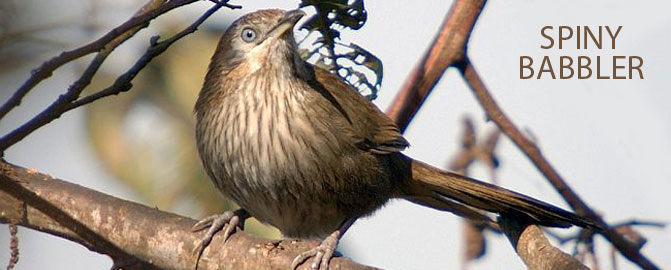Day 1: Kathmandu 1350m
Arrive Kathmandu, After checking into your hotel you will be briefed by your Tour leader on your program.

From ornithological point of view, the geographical position of Nepal and its own configuration offer a various diversity over about 878 species of birds in Nepal about 9% total bird population of the world recorded and some one can see different species of the bird including endemic species , spiny Babbler, and other great attraction Ibisbill and demoiselle Crane migration in the Himalayas . The great chain of the Himalayas forms a natural rampart between the high plateaux of Tibet and the sub tropical zone of Terai.
The richness and state of conservation of nature in Nepal are directly linked to the Hindu and Buddhist religion, respectful of the natural elements.
| Group Size : | 02 - 14 people | 2760m | |
| Destination : | Nepal | Fitness level : | Leisurely Plus |
| Trip Season : | Spring (Mar - May) / AUTUMN (Sept – Nov) | Departure from : | Kathmandu |
| Meals : | Breakfast in Kathmandu/Pokhara & full board in Chitwan |
| Accomodation : | 3 star Standard Hotel in Kathmandu/Pokhara /Chitwan |
| Trip Mode : | Lodge to lodge trek |
Arrive Kathmandu, After checking into your hotel you will be briefed by your Tour leader on your program.
After a very early breakfast we depart for Phulchowki 18km Southeast of Kathmandu. Phulchowki at 2760m is the highest of the mountains encircling the Kathmandu valley and provides an ideal introduction to the birds of Nepal. Regularly recorded resident species include Besra, Black Eagle, Mountain Hawk-Eagle, Kalij Pheasant, Common Hill Partridge, Ashy Woodpigeon, Wedge-tailed Green Pigeon, Mountain Scops Owl, Collared Owlet, Golden-throated Barbet, Speckled Piculet, Crimson-breasted Pied and Rufous-bellied Pied Woodpeckers, Grey-chinned Minivet, Striated Bulbul, Orange-bellied Leafbird, Spotted Forktail, Chestnut-headed and grey-bellied Tesias, Chestnut-crowned and black faced Warblers, Rufous-bellied Niltava, Lesser Scaly-breasted Wren Babbler, Streak-breasted Scimitar-Babbler, Grey-throated and Spiny Babbler ( which only found in Nepal ) , White-crested, striated, Rufous-chinned and grey-sided Laughing thrushes, Red-billed Leiothrix, Cuttia, White-browed Green and Black-eared Shrike-Babblers, Hoary Barwing, Blue-winged Minla, Nepal Fulvetta, Yellow-browed Tit, Brown-throated Treecreeper, Black-throated Sunbird, Maroon Oriole, Eurasian and Lancelated Jays, Red-billed Blue Magpie and Brown Bullfinch. A further 55 species have been known to visit the area as migratory or occasional visitors. Phulchowki’s forests are also very rich in flora and butterflies. Mammals include Leopard, Yellow-throated Marten and Orange-bellied Squirrel. After this fine introduction to Nepali Birds, we will return to our hotel in Kathmandu.
A scenic drive of approximately 7 hours plus a stop for lunch at Mugling beside the Trisuli River. The southern side of the lake is covered in extensive forest with rich bird life and excellent views of the Annapurna range, Phewa Lake and Pokhara. We will have plenty of time for a late afternoon exploration of this forest.
We explore in detail the forest along the southern shore of the lake. Apart from the many birds found here, you will also be rewarded with some of the best views of the Annapurnas and Machhapuchhare, Pokhara has to offer. Species regularly seen in this forest and along the shore of the lake include Besra, Red-thighed Falconet, Pallid and Pied Harriers, Eurasian Griffon, Red-headed and Eurasian Black Vultures, Kalij Pheasant, Ducks, Gulls, Terns, Waders, Bulbul, Black-backed Forktail, Puff-throated Babbler, White-crested, Lesser Necklaced and Rufous-chinned Laughing Thrushes, Red-billed Leiothrix, Minivetts, Crimson Sunbird, Maroon Oriole, Lesser Racket-tailed Drongo, Red-billed and Green Magpies, Long-tailed Mountain Thrush, Chestnut-headed and Grey-bellied Tesias, Chestnut-crowned Warbler, Small and Rufous-bellied Niltavas and Snowy-brown Flycatcher, Long-tailed Broadbill, Pale Blue Flycatcher, White-tailed Robin, Spiny Babbler, White-browed Scimitar-Babbler, Striated Munia, Lesser Whitethroat and Thick-billed Warbler.
Transfer by road from Pokhara to Chitwan. A drive of approx. 4 hours. After checking in, you will have time for a late afternoon Nature Walk or Elephant Safari. The Royal Chitwan National Park covers 932 sq. km. and supports some 450 species of birds. Flocks of Common and Demoiselle Cranes occur on passage between March and May and October/November. Along the marshes and small lakes there are Cormorants, Darter, Cinnamon Bittern, Black-crowned Night and Purple Herons, Asian Openbill, Woolly-necked and Lesser Adjutant Storks, Lesser Whistling Duck, Cotton Pygmy Goose, Balloons Ruddy-breasted and Brown Crakes, Purple Gallinule, Bronze-winged Jacana, Painted Snipe and Stork-billed Kingfisher, Chestnut-crowned and Spotted Bush Warblers, Yellow bellied Prinia, Clamorous Reed, dusky and Smoky Warblers, and Red-capped Babbler. Forest species regular seen are Lesser Fishing and Grey headed Eagle, Brown Fish Owl, Changeable Hawk-Eagle, Kalij Pheasant, Emerald Dove, Orange-breasted Green and Pompadour Green Pigeon, Moustached Parakeet, Green-billed Malkoha, Brown Hawk Owl, Crested Treeswift, Pied and Great Hornbills, Streak-throated Green, Rufous, Himalayan Golden-backed and Greater Golden- backed Woodpeckers, Large Woodshrike Rosy Minivet, Black- crested Bulbul, Golden fronted Leafbird, Pale-chinned Flycatcher, Black-napped Monarch, Puff-throated Babbler, White-browed Scimitar-Babbler, Grey-throated Babbler, Crimson Sunbird, Thick-billed Flowerpecker, Hill Mynah, Black-hooded Oriole, White-rumped Shama, Lesser Necklaced, Greater Necklaced and Rufous-necked Laughing-thrushes, Nepal Fulvetta, Streaked Spiderhunter, yellow-bellied Warbler, Rufous-bellied Eagle, Forest Eagle, Tawny Fish Owls, Red-headed Trogon, White-browed Piculet, Great Slaty Woodpecker, Long-tailed Broadbill, Ruby-cheeked Sunbird and Little Spiderhunter.
Full day Safari Program.
We depart the Lodge by Land Rover for an excursion further into the Chitwan National Park.
After lunch we have a one hour drive to Hedauda where hopefully we will find the very rare Ibisbill in the gravel beside the Rapti river.
After an early morning Birdwatching walk we transfer by road to Kathmandu.
Depart Kathmandu.
